Valuation of Ecosystem Services in South Africa, 2001–2019
Abstract
:1. Introduction
2. Materials and Methods
3. Results
3.1. Land-Cover Change
- Water bodies show a declining trend throughout;
- Forests of different sorts increase;
- Open shrubland and grassland decrease;
- Croplands increase;
- Urban areas increase.
3.2. Changes in Net Primary Productivity as Proxy for Land Degradation
3.3. Valuation of Ecosystem Services Using Combined Approach of NPP and Land Cover
4. Discussion
4.1. Land-Cover Changes and Their Implications
4.2. Valuation of Ecosystem Services
4.3. Implications for Climate Change, Land Degradation and Sustainable Development
5. Conclusions
Author Contributions
Funding
Institutional Review Board Statement
Informed Consent Statement
Data Availability Statement
Acknowledgments
Conflicts of Interest
References
- Costanza, R.; D’Arge, R.; de Groot, R.; Farber, S.; Grasso, M.; Hannon, B.; Limburg, K.; Naeem, S.; O’Neill, R.V.; Paruelo, J.; et al. The value of the world’s ecosystem services and natural capital. Nature 1997, 387, 253–260. [Google Scholar] [CrossRef]
- Costanza, R.; Kubiszewski, I.; Ervin, D.; Bluffstone, R.; Boyd, J.; Brown, D.; Chang, H.; Dujon, V.; Granek, E.; Polasky, S.; et al. Valuing ecological systems and services. F1000 Biol. Rep. 2011, 3, 14. [Google Scholar] [CrossRef] [Green Version]
- Costanza, R.; de Groot, R.; Sutton, P.; van der Ploeg, S.; Anderson, S.J.; Kubiszewski, I.; Farber, S.; Turner, R.K. Changes in the global value of ecosystem services. Glob. Environ. Chang. 2014, 26, 152–158. [Google Scholar] [CrossRef]
- Walters, C.J.; Christensen, V.; Martell, S.J.; Kitchell, J.F. Possible ecosystem impacts of applying MSY policies from single-species assessment. ICES J. Mar. Sci. 2005, 62, 558–568. [Google Scholar] [CrossRef] [Green Version]
- Egoh, B.; Reyers, B.; Rouget, M.; Richardson, D.M.; Le Maitre, D.C.; van Jaarsveld, A.S. Mapping ecosystem services for planning and management. Agric. Ecosyst. Environ. 2008, 127, 135–140. [Google Scholar] [CrossRef]
- Daily, G.C.; Matson, P.A.; Vitousek, P.M. Ecosystem services supplied by soil. In Nature’s Services: Societal Dependence on Natural Ecosystems; Daily, G., Ed.; Island Press: Washington, DC, USA, 1997; pp. 113–132. [Google Scholar]
- Jackson, S.; Palmer, L.R. Reconceptualizing ecosystem services: Possibilities for cultivating and valuing the ethics and practices of care. Progr. Hum. Geogr. 2015, 39, 122–145. [Google Scholar] [CrossRef] [Green Version]
- Grimmond, S.; Bouchet, V.; Molina, L.T.; Baklanov, A.; Tan, J.; Schlünzen, K.H.; Mills, G.; Golding, B.; Masson, V.; Ren, C.; et al. Integrated urban hydrometeorological, climate and environmental services: Concept, methodology and key messages. Urban Clim. 2020, 33, 100623. [Google Scholar] [CrossRef]
- Gómez-Baggethun, E.; Ruiz-Pérez, M. Economic valuation and the commodification of ecosystem services. Progr. Phys. Geogr. 2011, 35, 613–628. [Google Scholar] [CrossRef] [Green Version]
- Van Noordwijk, M.; Leimona, B.; Jindal, R.; Villamor, G.B.; Vardhan, M.; Namirembe, S.; Catacutan, D.; Kerr, J.; Minang, P.A.; Tomich, T.P. Payments for environmental services: Evolution toward efficient and fair incentives for multifunctional landscapes. Ann. Rev. Environ. Res. 2012, 37, 389–420. [Google Scholar] [CrossRef]
- MEA [Millennium Ecosystems Assessment]. Ecosystems and Human Well-being: Synthesis; Island Press: Washington, DC, USA, 2005. [Google Scholar]
- Sen, S.; Guchhait, S.K. Urban green space in India: Perception of cultural ecosystem services and psychology of situatedness and connectedness. Ecol. Indic. 2021, 123, 107338. [Google Scholar] [CrossRef]
- Smiraglia, D.; Ceccarelli, T.; Bajocco, S.; Salvati, L.; Perini, L. Linking trajectories of land change, land degradation processes and ecosystem services. Environ. Res. 2016, 147, 590–600. [Google Scholar] [CrossRef] [PubMed]
- Sutton, P.; Anderson, S.; Costanza, R.; Kubiszewski, I. The ecological economics of land degradation: Impacts on ecosystem service values. Ecol. Econ. 2016, 129, 182–192. [Google Scholar] [CrossRef]
- Tarrasón, D.; Ravera, F.; Reed, M.S.; Dougill, A.J.; Gonzalez, L. Land degradation assessment through an ecosystem services lens: Integrating knowledge and methods in pastoral semi-arid systems. J. Arid Environ. 2016, 124, 205–213. [Google Scholar] [CrossRef]
- Turner, K.G.; Anderson, S.; Gonzales-Chang, M.; Costanza, R.; Courville, S.; Dalgaard, T.; Dominati, E.; Kubiszewski, I.; Ogilvy, S.; Porfirio, L.; et al. A review of methods, data, and models to assess changes in the value of ecosystem services from land degradation and restoration. Ecol. Modell. 2016, 319, 190–207. [Google Scholar] [CrossRef]
- Boerema, A.; Rebelo, A.J.; Bodi, M.B.; Esler, K.J.; Meire, P. Are ecosystem services adequately quantified? J. Appl. Ecol. 2017, 54, 358–370. [Google Scholar] [CrossRef]
- Cerretelli, S.; Poggio, L.; Gimona, A.; Yakob, G.; Boke, S.; Habte, M.; Coull, M.; Peressotti, A.; Black, H. Spatial assessment of land degradation through key ecosystem services: The role of globally available data. Sci. Total Environ. 2018, 628–629, 539–555. [Google Scholar] [CrossRef]
- Dhanya, B.; Sathish, B.N.; Viswanath, S.; Purushothaman, S. Ecosystem services of native trees: Experiences from two traditional agroforestry systems in Karnataka, Southern India. Int. J. Biodiv. Sci. Ecosyst. Serv. Manag. 2014, 10, 101–111. [Google Scholar] [CrossRef]
- Schild, J.E.M.; Vermaat, J.E.; de Groot, R.S.; Quatrini, S.; van Bodegom, P.M. A global meta-analysis on the monetary valuation of dryland ecosystem services: The role of socio-economic, environmental and methodological indicators. Ecosyst. Serv. 2018, 32, 78–89. [Google Scholar] [CrossRef] [Green Version]
- Rieprich, R.; Schnegg, M. The value of landscapes in northern Namibia: A system of intertwined material and nonmaterial services. Soc. Nat. Res. 2015, 28, 941–958. [Google Scholar] [CrossRef] [Green Version]
- Del Río-Mena, T.; Willemen, L.; Tesfamariam, G.T.; Beukes, O.; Nelson, A. Remote sensing for mapping ecosystem services to support evaluation of ecological restoration interventions in an arid landscape. Ecol. Indic. 2020, 113, 106182. [Google Scholar] [CrossRef]
- Mowat, S.; Rhodes, B. Identifying and assigning values to the intangible cultural benefits of ecosystem services to traditional communities in South Africa. S. Afr. J. Sci. 2020, 116, 6970. [Google Scholar] [CrossRef]
- Van Jaarsveld, A.S.; Biggs, R.; Scholes, R.J.; Bohensky, E.; Reyers, B.; Lynam, T.; Musvoto, C.; Fabricius, C. Measuring conditions and trends in ecosystem services at multiple scales: The Southern African Millennium Ecosystem Assessment (SAfMA) experience. Philos. Trans. R. Soc. Ser. B 2005, 360, 425–441. [Google Scholar] [CrossRef] [PubMed] [Green Version]
- Huang, X.; Han, X.; Ma, S.; Lin, T.; Gong, J. Monitoring ecosystem service change in the City of Shenzhen by the use of high-resolution remotely sensed imagery and deep learning. Land Degrad. Dev. 2019, 30, 1490–1501. [Google Scholar] [CrossRef]
- Nyamekye, C.; Schönbrodt-Stitt, S.; Amekudzi, L.K.; Zoungrana, B.J.-B.; Thiel, M. Usage of MODIS NDVI to evaluate the effect of soil and water conservation measures on vegetation in Burkina Faso. Land Degrad. Dev. 2021, 32, 7–19. [Google Scholar] [CrossRef]
- Wessels, K.J.; Prince, S.D.; Malherbe, J.; Small, J.; Frost, P.E.; VanZyl, D. Can human-induced land degradation be distinguished from the effects of rainfall variability? A case study in South Africa. J. Arid Environ. 2007, 68, 271–297. [Google Scholar] [CrossRef]
- Harris, A.; Carr, A.S.; Dash, J. Remote sensing of vegetation cover dynamics and resilience across southern Africa. Int. J. Appl. Earth Obs. Geoinform. 2014, 28, 131–139. [Google Scholar] [CrossRef]
- Christie, M.; Fazey, I.; Cooper, R.; Hyde, T.; Kenter, J.O. An evaluation of monetary and non-monetary techniques for assessing the importance of biodiversity and ecosystem services to people in countries with developing economies. Ecol. Econ. 2012, 83, 67–78. [Google Scholar] [CrossRef]
- Dikgang, J.; Muchapondwa, E. Local communities’ valuation of environmental amenities around the Kgalagadi Transfrontier Park in Southern Africa. J. Environ. Econ. Pol. 2017, 6, 168–182. [Google Scholar] [CrossRef]
- Browne, M.; Fraser, G.; Snowball, J. Economic evaluation of wetland restoration: A systematic review of the literature. Restor. Ecol. 2018, 26, 1120–1126. [Google Scholar] [CrossRef]
- Baba, C.A.K.; Hack, J. Economic valuation of ecosystem services for the sustainable management of agropastoral dams. A case study of the Sakabansi dam, northern Benin. Ecol. Indic. 2019, 107, 105648. [Google Scholar] [CrossRef]
- Möller, A.; Ranke, U. Estimation of the on-farm-costs of soil erosion in Sleman, Indonesia. WIT Trans. Ecol. Environ. 2006, 89, 43–52. [Google Scholar]
- Lele, S. Watershed services of tropical forests: From hydrology to economic valuation to integrated analysis. Curr. Opin. Environ. Sustain. 2009, 1, 148–155. [Google Scholar] [CrossRef]
- De Wit, M.; Zyl, H.; Crookes, D.; Blignaut, J.; Jayiya, T.; Goiset, V.; Mahumani, B. Including the economic value of well-functioning urban ecosystems in financial decisions: Evidence from a process in Cape Town. Ecosyst. Serv. 2012, 2, 38–44. [Google Scholar] [CrossRef]
- O’Farrell, P.J.; De Lange, W.J.; Le Maitre, D.C.; Reyers, B.; Blignaut, J.N.; Milton, S.J.; Atkinson, D.; Egoh, B.; Maherry, A.; Colvin, C.; et al. The possibilities and pitfalls presented by a pragmatic approach to ecosystem service valuation in an arid biodiversity hotspot. J. Arid Environ. 2011, 75, 612–623. [Google Scholar] [CrossRef] [Green Version]
- Favretto, N.; Luedeling, E.; Stringer, L.C.; Dougill, A.J. Valuing ecosystem services in semi-arid rangelands through stochastic simulation. Land Degrad. Dev. 2017, 28, 65–73. [Google Scholar] [CrossRef]
- Tully, K.; Sullivan, C.; Weil, R.; Sanchez, P. The State of Soil Degradation in Sub-Saharan Africa: Baselines, Trajectories, and Solutions. Sustainability 2015, 7, 6523–6552. [Google Scholar] [CrossRef] [Green Version]
- Matarira, D.; Mutanga, O.; Dube, T. Landscape scale land degradation mapping in the semi-arid areas of the Save catchment, Zimbabwe. S. Afr. Geogr. J. 2021, 103, 183–203. [Google Scholar] [CrossRef]
- Vitousek, P.M.; Ehrlich, P.R.; Ehrlich, A.H.; Matson, P.A. Human appropriation of the products of photosynthesis. BioScience 1986, 36, 368–373. [Google Scholar] [CrossRef]
- Rojstaczer, S.; Sterling, S.M.; Moore, N.J. Human appropriation of photosynthesis products. Science 2001, 294, 2549–2552. [Google Scholar] [CrossRef]
- Le, Q.B.; Nkonya, E.; Mirzabaev, A. Biomass Productivity-Based Mapping of Global Land Degradation Hotspots; ZEF Discussion Papers on Development Policy 193; ZEF: Bonn, Germany, 2014. [Google Scholar]
- Von Braun, J.; Gerber, N.; Mirzabaev, A.; Nkonya, E. The Economics of Land Degradation; ZEF Working Paper Series 109; ZEF: Bonn, Germany, 2013. [Google Scholar]
- Dubovyk, O. The role of Remote Sensing in land degradation assessments: Opportunities and challenges. Eur. J. Remote Sens. 2017, 50, 601–613. [Google Scholar] [CrossRef]
- Venter, Z.S.; Scott, S.L.; Desmet, P.G.; Hoffman, M.T. Application of Landsat-derived vegetation trends over South Africa: Potential for monitoring land degradation and restoration. Ecol. Indic. 2020, 113, 106206. [Google Scholar] [CrossRef]
- Ardö, J. Comparison between remote sensing and a dynamic vegetation model for estimating terrestrial primary production of Africa. Carb. Bal. Manag. 2015, 10, 8. [Google Scholar] [CrossRef] [PubMed] [Green Version]
- Pan, S.; Dangal, S.R.S.; Tao, B.; Yang, J.; Tian, H. Recent patterns of terrestrial net primary production in Africa influenced by multiple environmental changes. Ecosyst. Health Sustain. 2015, 1, 18. [Google Scholar] [CrossRef] [Green Version]
- Higginbottom, T.P.; Symeonakis, E. Identifying Ecosystem Function Shifts in Africa Using Breakpoint Analysis of Long-Term NDVI and RUE Data. Remote Sens. 2020, 12, 1894. [Google Scholar] [CrossRef]
- Clover, J.; Eriksen, S. The effects of land tenure change on sustainability: Human security and environmental change in southern African savannas. Environ. Sci. Pol. 2009, 12, 53–70. [Google Scholar] [CrossRef]
- Andersson, E.; Brogaard, S.; Olsson, L. The Political Ecology of Land Degradation. Ann. Rev. Environ. Res. 2021, 36, 295–319. [Google Scholar] [CrossRef]
- Sigwela, A.; Elbakidze, M.; Powell, M.; Angelstam, P. Defining core areas of ecological infrastructure to secure rural livelihoods in South Africa. Ecosyst. Serv. 2017, 27, 272–280. [Google Scholar] [CrossRef]
- Smith, P.; Calvin, K.; Nkem, J.; Campbell, D.; Cherubini, F.; Grassi, G.; Korotkov, V.; Le Hoang, A.; Lwasa, S.; McElwee, P.; et al. Which practices co-deliver food security, climate change mitigation and adaptation, and combat land degradation and desertification? Glob. Chang. Biol. 2020, 26, 1532–1575. [Google Scholar] [CrossRef] [PubMed] [Green Version]
- Turpie, J.K.; Forsythe, K.J.; Knowles, A.; Blignaut, J.; Letley, G. Mapping and valuation of South Africa’s ecosystem services: A local perspective. Ecosyst. Serv. 2017, 27, 179–192. [Google Scholar] [CrossRef]
- Sulla-Menashe, D.; Gray, J.M.; Abercrombie, S.P.; Friedl, M.A. Hierarchical mapping of annual global land cover 2001 to present: The MODIS Collection 6 Land Cover product. Remote Sens. Environ. 2019, 222, 183–194. [Google Scholar] [CrossRef]
- Running, S.; Mu, Q.; Zhao, M. MYD17A3H MODIS/Aqua Net Primary Production Yearly L4 Global 500m SIN Grid V006 [Dataset]. NASA EOSDIS Land Processes DAAC. Available online: https://lpdaac.usgs.gov/products/myd17a3hv006/ (accessed on 21 January 2015). [CrossRef]
- De Groot, R.S.; Wilson, M.A.; Boumans, R.M.J. A typology for the classification, description and valuation of ecosystem functions, goods and services. Ecol. Econ. 2002, 41, 393–408. [Google Scholar] [CrossRef] [Green Version]
- Pachavo, G.; Murwira, A. Remote sensing net primary productivity (NPP) estimation with theaid of GIS modelled shortwave radiation (SWR) in a Southern African Savanna. Int. J. Appl. Earth Obs. Geoinform. 2014, 30, 217–226. [Google Scholar] [CrossRef]
- Running, S.W.; Zhao, M. Daily GPP and Annual NPP (MOD17A2H/A3H) and Year-end Gap-Filled (MOD17A2HGF/A3HGF) Products NASA Earth Observing System MODIS Land Algorithm. Available online: https://lpdaac.usgs.gov/documents/495/MOD17_User_Guide_V6.pdf (accessed on 28 February 2021).
- Cheng, B.-Y.; Zhang, Q.; Lyapustin, A.I.; Wang, Y.; Middleton, E.M. Impacts of light use efficiency and fPAR parameterization on gross primary production modelling. Agric. Forest Meteorol. 2014, 189–190, 187–197. [Google Scholar] [CrossRef]
- Tswai, D.R.; Malherbe, J.; Dekker, C.; Mashimbye, Z.E.; Van den Berg, E.C.; Nyamugama, A.; Elbasit, M.A.M.; Chirima, J.G.; Nell, J.P.; Nkambule, V.T. Phase 1 of Desertification, Land Degradation and Drought (DLDD) land cover mapping impact indicator of the United Nations Convention to Combat Desertification (UNCCD); DEA: Pretoria, South Africa, 2016.
- Xulu, S.; Peerbhay, K.; Gebreslasie, M.; Ismail, R. Unsupervised Clustering of Forest Response to Drought Stress in Zululand Region, South Africa. Forests 2019, 10, 531. [Google Scholar] [CrossRef] [Green Version]
- Wessels, K.J.; van den Bergh, F.; Scholes, R.J. Limits to detectability of land degradation by trend analysis of vegetation index data. Remote Sens. Environ. 2012, 125, 10–22. [Google Scholar] [CrossRef]
- Jury, M.R. Climate trends in southern Africa. S. Afr. J. Sci. 2013, 109, 980. [Google Scholar] [CrossRef] [Green Version]
- Favre, A.; Philippon, N.; Pohl, B.; Kalognomou, E.-A.; Lennard, C.; Hewitson, B.; Nikulin, G.; Dosio, A.; Panitz, H.-J.; Cerezo-Mota, R. Spatial distribution of precipitation annual cycles over South Africa in 10 CORDEX regional climate model present-day simulations. Clim. Dyn. 2016, 46, 1799–1818. [Google Scholar] [CrossRef]
- Kolusu, S.R.; Shamsudduha, M.; Todd, M.C.; Taylor, R.G.; Seddon, D.; Kashaigili, J.J.; Ebrahim, G.Y.; Cuthbert, M.O.; Sorensen, J.P.R.; Villholth, K.G.; et al. The El Niño event of 2015–2016: Climate anomalies and their impact on groundwater resources in East and Southern Africa. Hydrol. Earth Syst. Sci. 2019, 23, 1751–1762. [Google Scholar] [CrossRef] [Green Version]
- Rouget, M.; Cowling, R.M.; Pressey, R.L.; Richardson, D.M. Identifying spatial components of ecological and evolutionary processes for regional conservation planning in the Cape Floristic Region, South Africa. Divers. Distrib. 2003, 9, 191–210. [Google Scholar] [CrossRef]
- Midgley, G.F.; Hannah, L.; Millar, D.; Thuiller, W.; Booth, A. Developing regional and species-level assessments of climate change impacts on biodiversity in the Cape Floristic Region. Biol. Conserv. 2003, 112, 87–97. [Google Scholar] [CrossRef]
- Masubelele, M.L.; Hoffman, M.T.; Bond, W.J.; Gambiza, J. A 50 year study shows grass cover has increased in shrublands of semi-arid South Africa. J. Arid Environ. 2014, 104, 43–51. [Google Scholar] [CrossRef]
- Stevens, N.; Erasmus, B.F.N.; Archibald, S.; Bond, W.J. Woody encroachment over 70 years in South African savannahs: Overgrazing, global change or extinction aftershock? Philos. Trans. R. Soc. Ser. B 2016, 371, 20150437. [Google Scholar] [CrossRef] [PubMed] [Green Version]
- Lawal, S.; Lennard, C.; Hewitson, B. Response of southern African vegetation to climate change at 1.5 and 2.0° global warming above the pre-industrial level. Clim. Serv. 2019, 16, 100134. [Google Scholar] [CrossRef]
- Skowno, A.L.; Jewitt, D.; Slingsby, J.A. Rates and patterns of habitat loss across South Africa’s vegetation biomes. S. Afr. J. Sci. 2021, 117, 8182. [Google Scholar] [CrossRef]
- Turpie, J.K. The existence value of biodiversity in South Africa: How interest, experience, knowledge, income and perceived level of threat influence local willingness to pay. Ecol. Econ. 2003, 46, 199–216. [Google Scholar] [CrossRef]
- Chisholm, R.A. Trade-offs between ecosystem services: Water and carbon in a biodiversity hotspot. Ecol. Econ. 2010, 69, 1973–1987. [Google Scholar] [CrossRef]
- Bourne, A.; Muller, H.; de Villiers, A.; Alam, M.; Hole, D. Assessing the efficiency and effectiveness of rangeland restoration in Namaqualand, South Africa. Plant Ecol. 2017, 218, 7–22. [Google Scholar] [CrossRef]
- Willemen, L.; Crossman, N.D.; Quatrini, S.; Egoh, B.; Kalaba, F.K.; Mbilinyi, B.; de Groot, R. Identifying ecosystem service hotspots for targeting land degradation neutrality investments in south-eastern Africa. J. Arid Environ. 2018, 159, 75–86. [Google Scholar] [CrossRef]
- Crookes, D.J.; Blignaut, J.N. Investing in natural capital and national security: A comparative review of restoration projects in South Africa. Heliyon 2019, 5, e01765. [Google Scholar] [CrossRef] [Green Version]
- Young, A.J.; Guo, D.; Desmet, P.G.; Midgley, G.F. Biodiversity and climate change: Risks to dwarf succulents in Southern Africa. J. Arid Environ. 2016, 129, 16–24. [Google Scholar] [CrossRef]
- Bezeng, B.S.; Yessoufou, K.; Taylor, P.J.; Tesfamichael, S.G. Expected spatial patterns of alien woody plants in South Africa’s protected areas under current scenario of climate change. Sci. Rep. 2020, 10, 7038. [Google Scholar] [CrossRef] [PubMed]
- Skowno, A.L.; Thompson, M.W.; Hiestermann, J.; Ripley, B.; West, A.G.; Bond, W.J. Woodland expansion in South African grassy biomes based on satellite observations (1990–2013): General patterns and potential drivers. Glob. Chang. Biol. 2017, 23, 2358–2369. [Google Scholar] [CrossRef] [PubMed]
- Scheiter, S.; Gaillard, C.; Martens, C.; Erasmus, B.F.N.; Pfeiffer, M. How vulnerable are ecosystems in the Limpopo province to climate change? S. Afr. J. Bot. 2018, 116, 86–95. [Google Scholar] [CrossRef]
- Knight, J. Environmental services: A new approach towards addressing Sustainable Development Goals in sub-Saharan Africa. Front. Sustain. Food Syst. 2021, 5, 687863. [Google Scholar] [CrossRef]
- Cilliers, S.; Cilliers, J.; Lubbe, R.; Siebert, S. Ecosystem services of urban green spaces in African countries—Perspectives and challenges. Urban Ecosyst. 2013, 16, 681–702. [Google Scholar] [CrossRef]
- Pfab, M. The quartzite ridges of Gauteng. Veld Flora 2002, 88, 56–59. [Google Scholar]

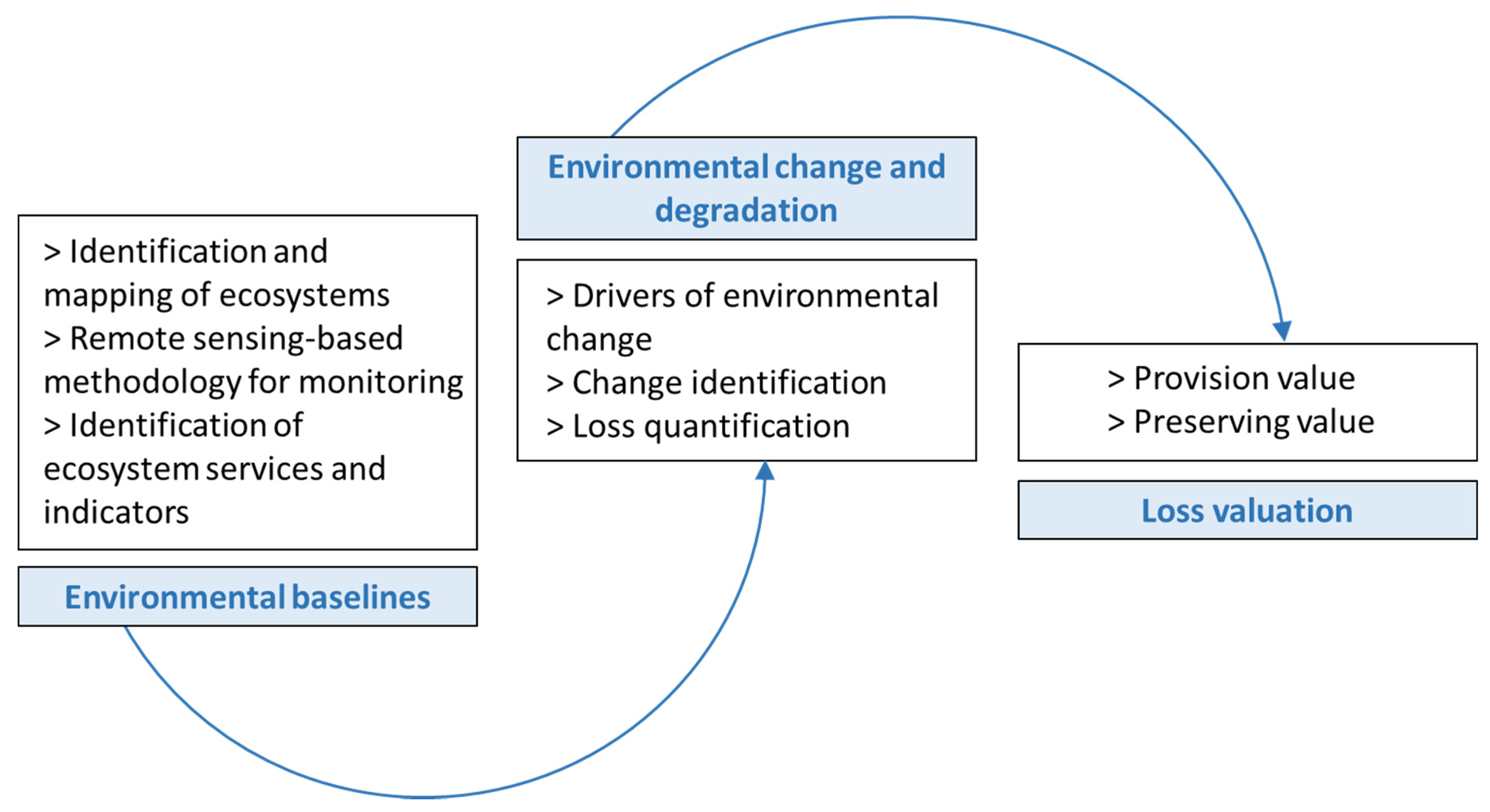
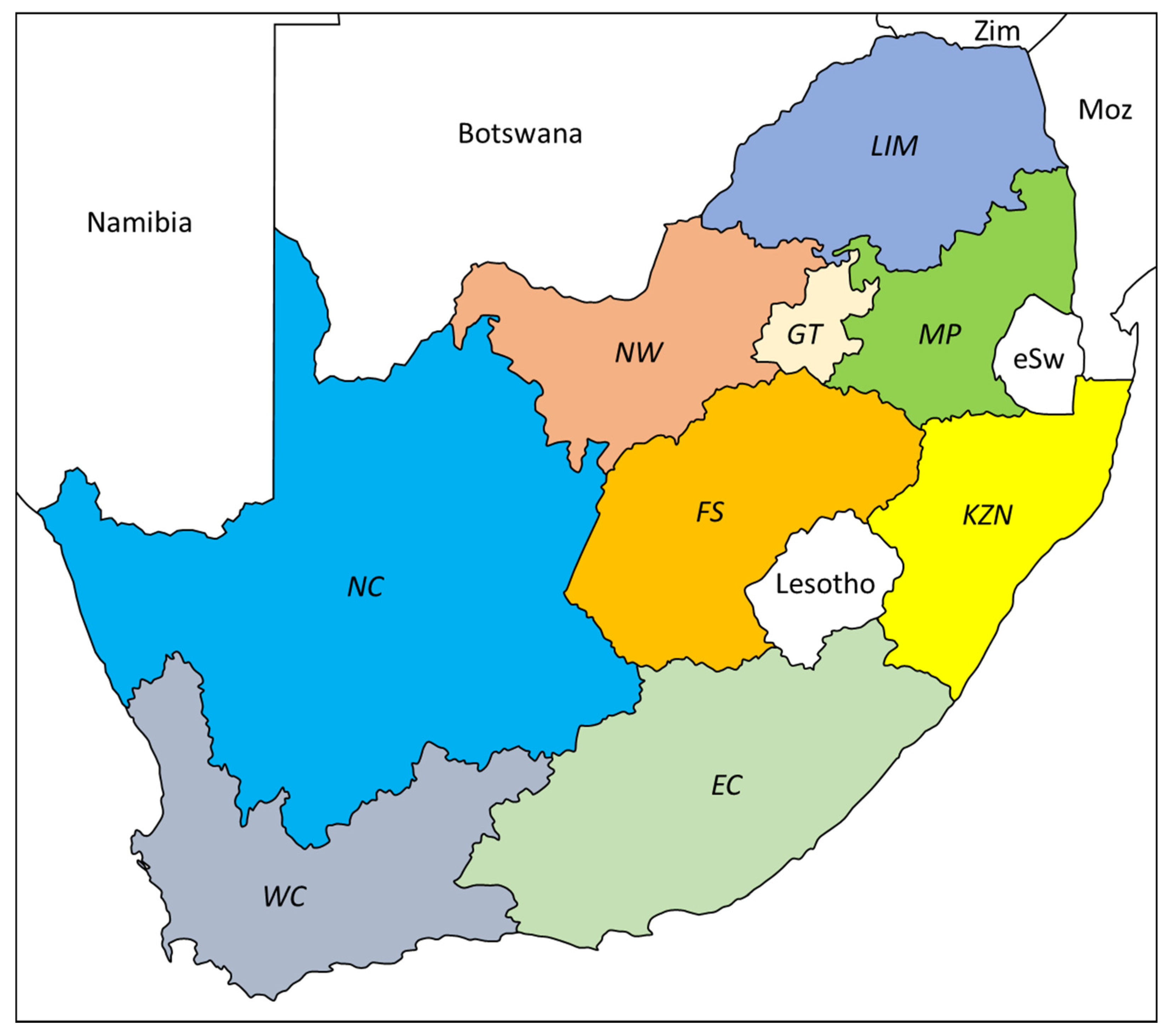
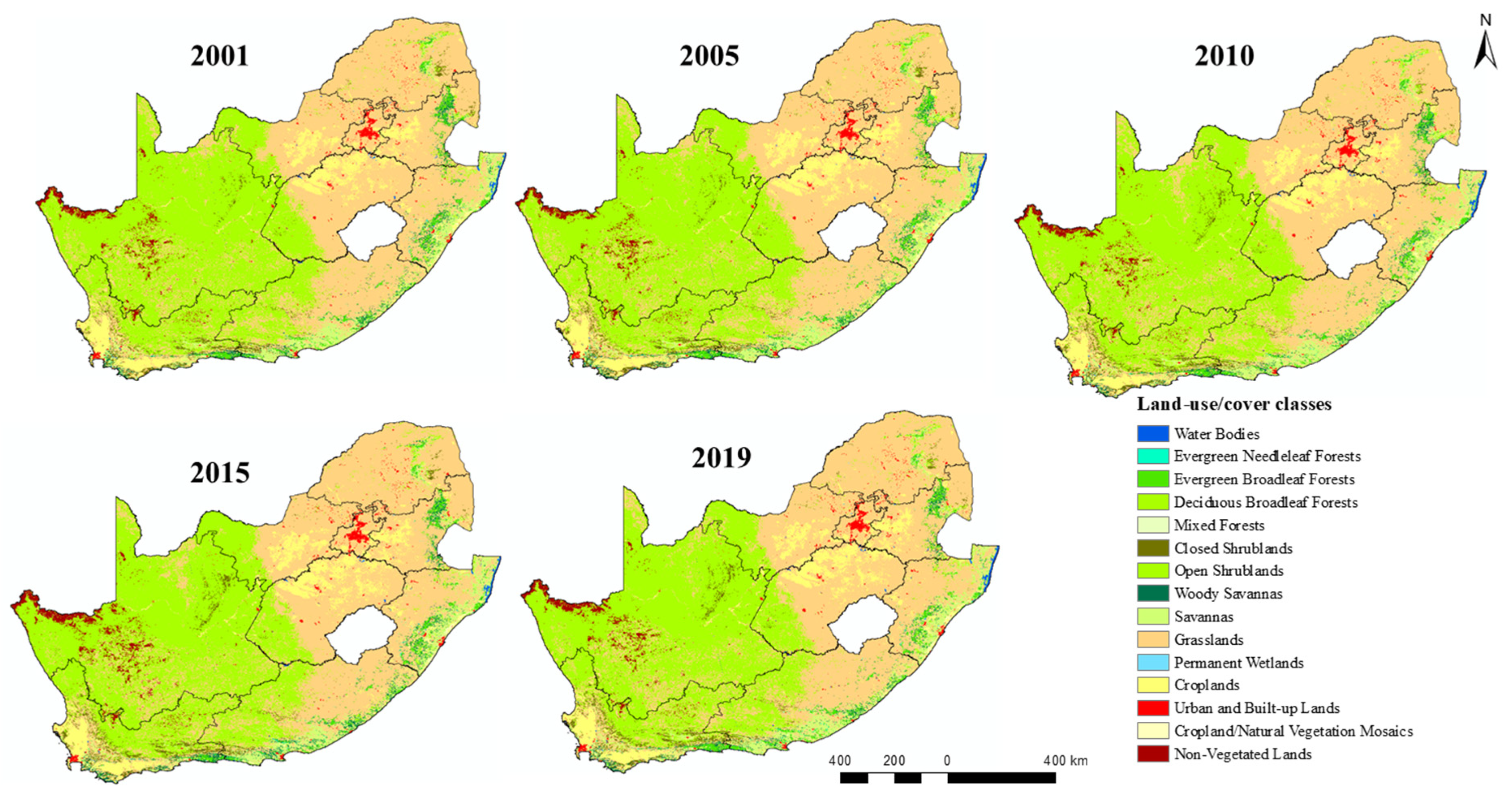
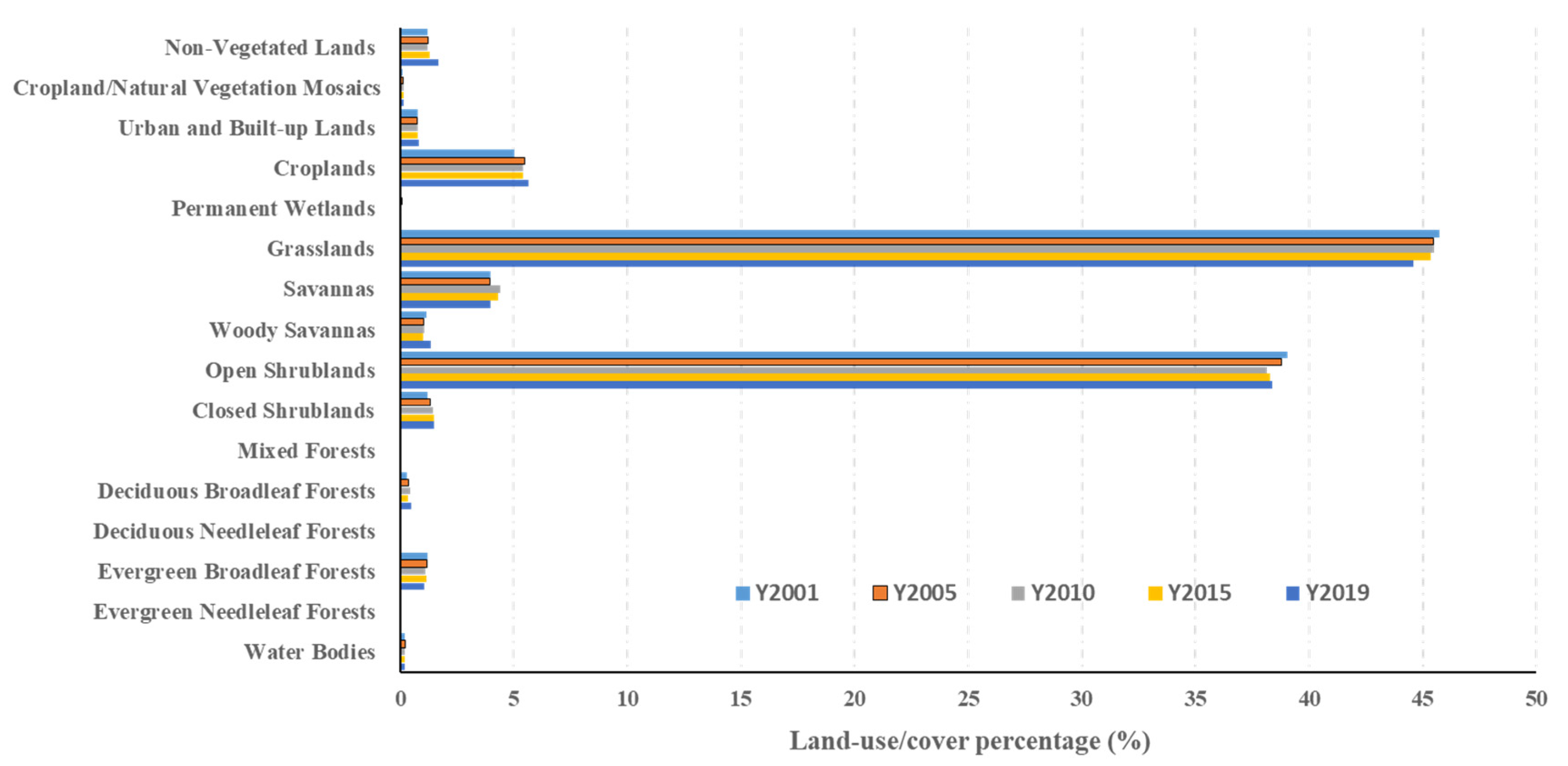
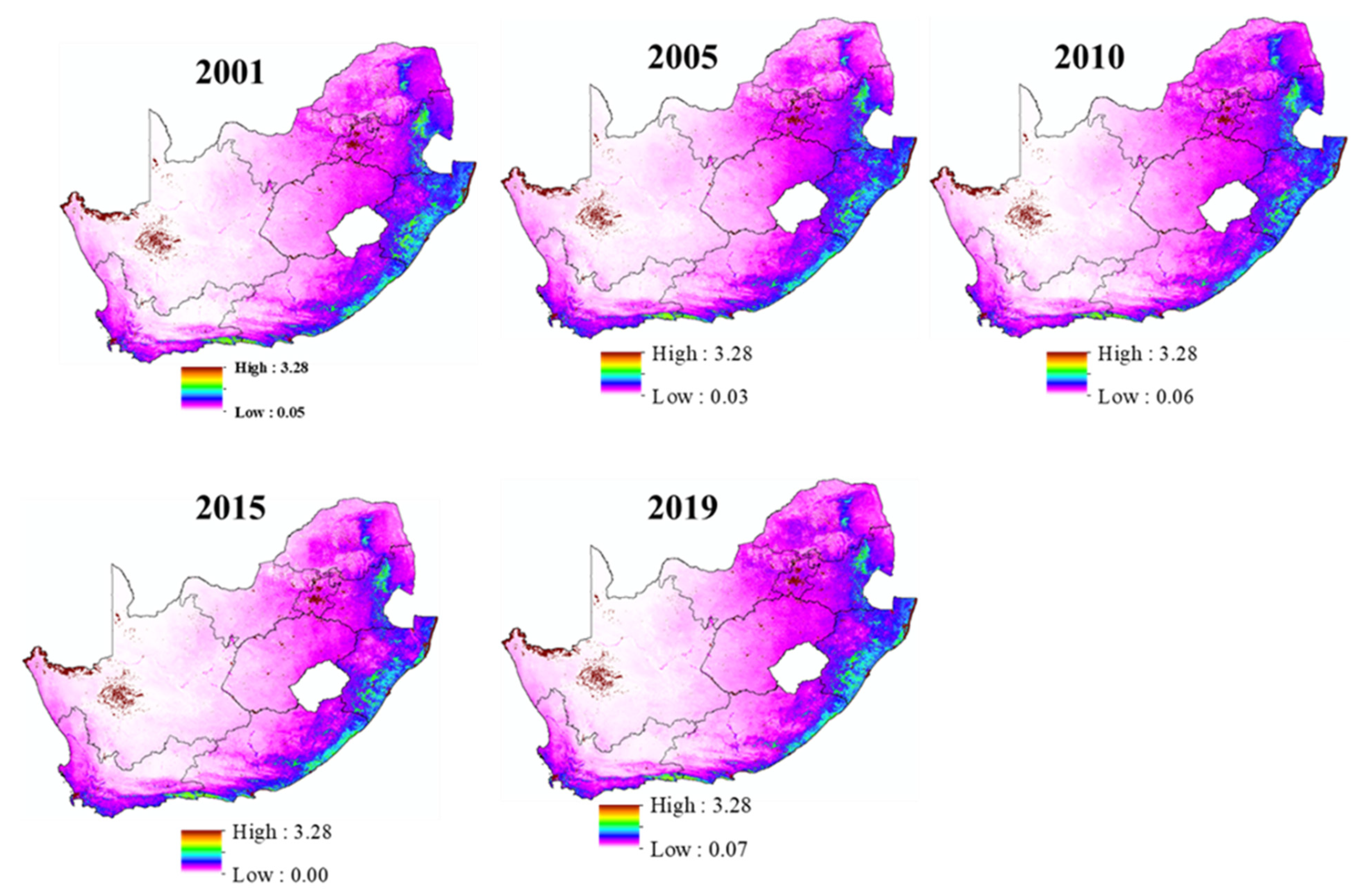
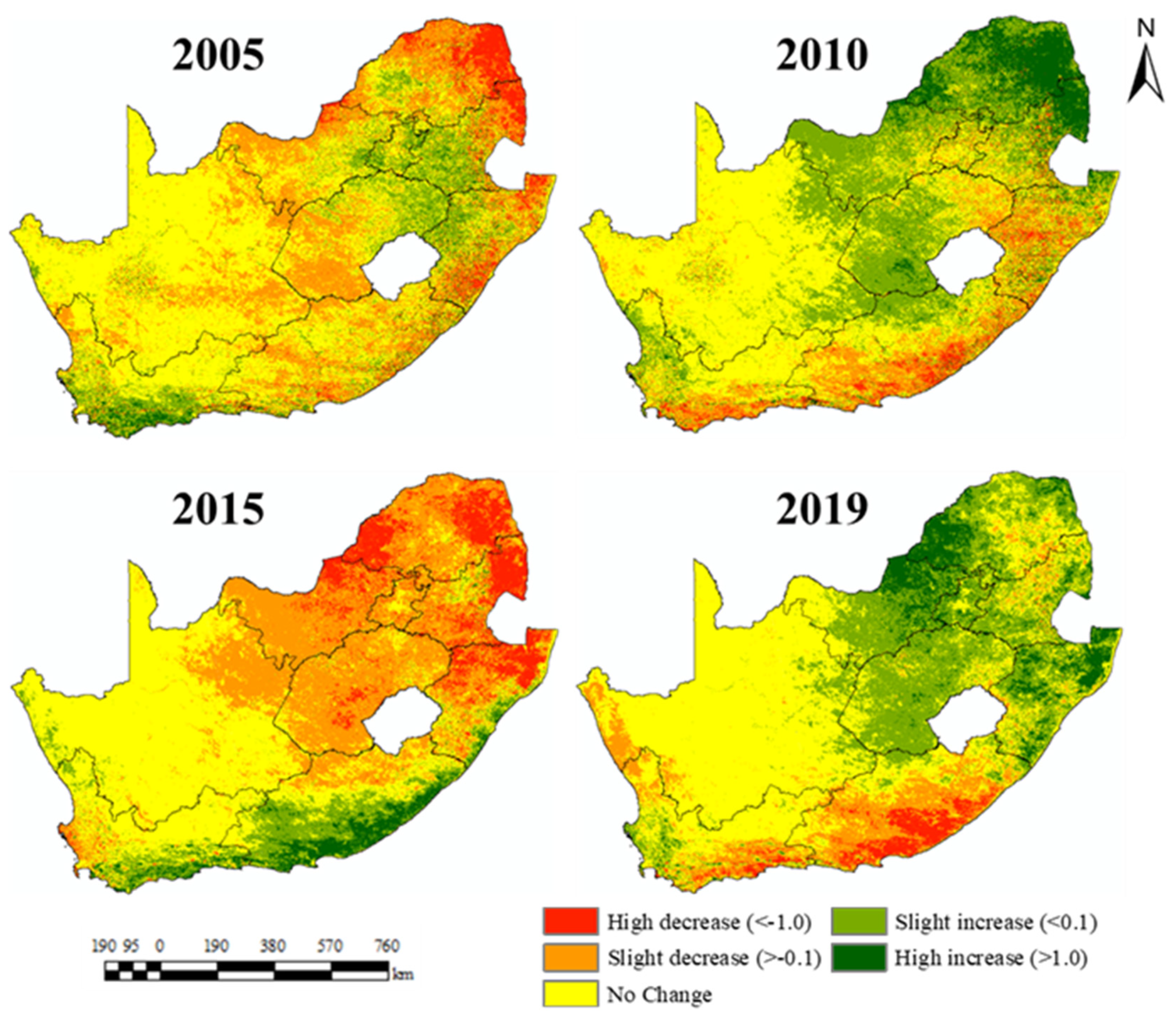
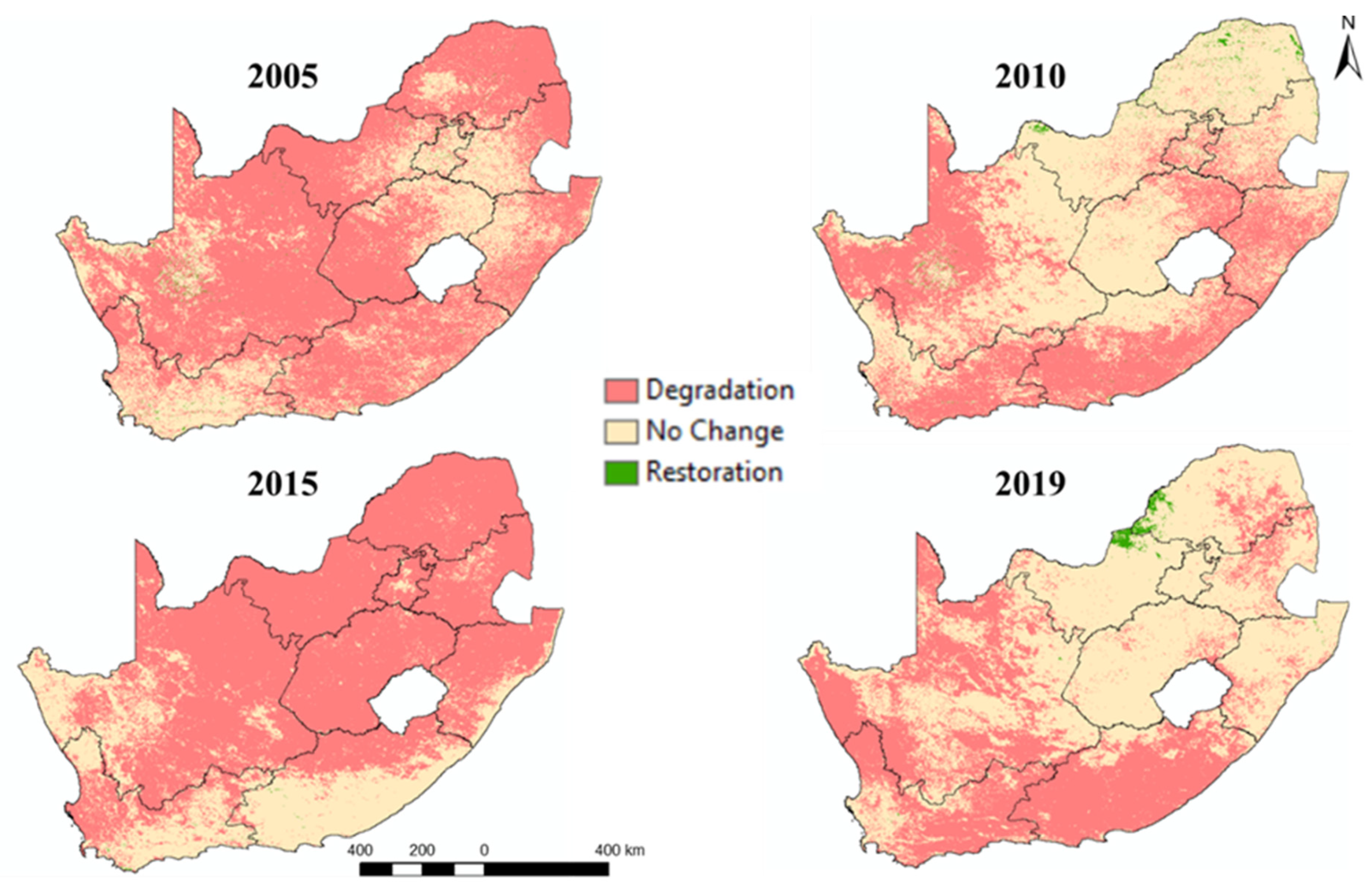
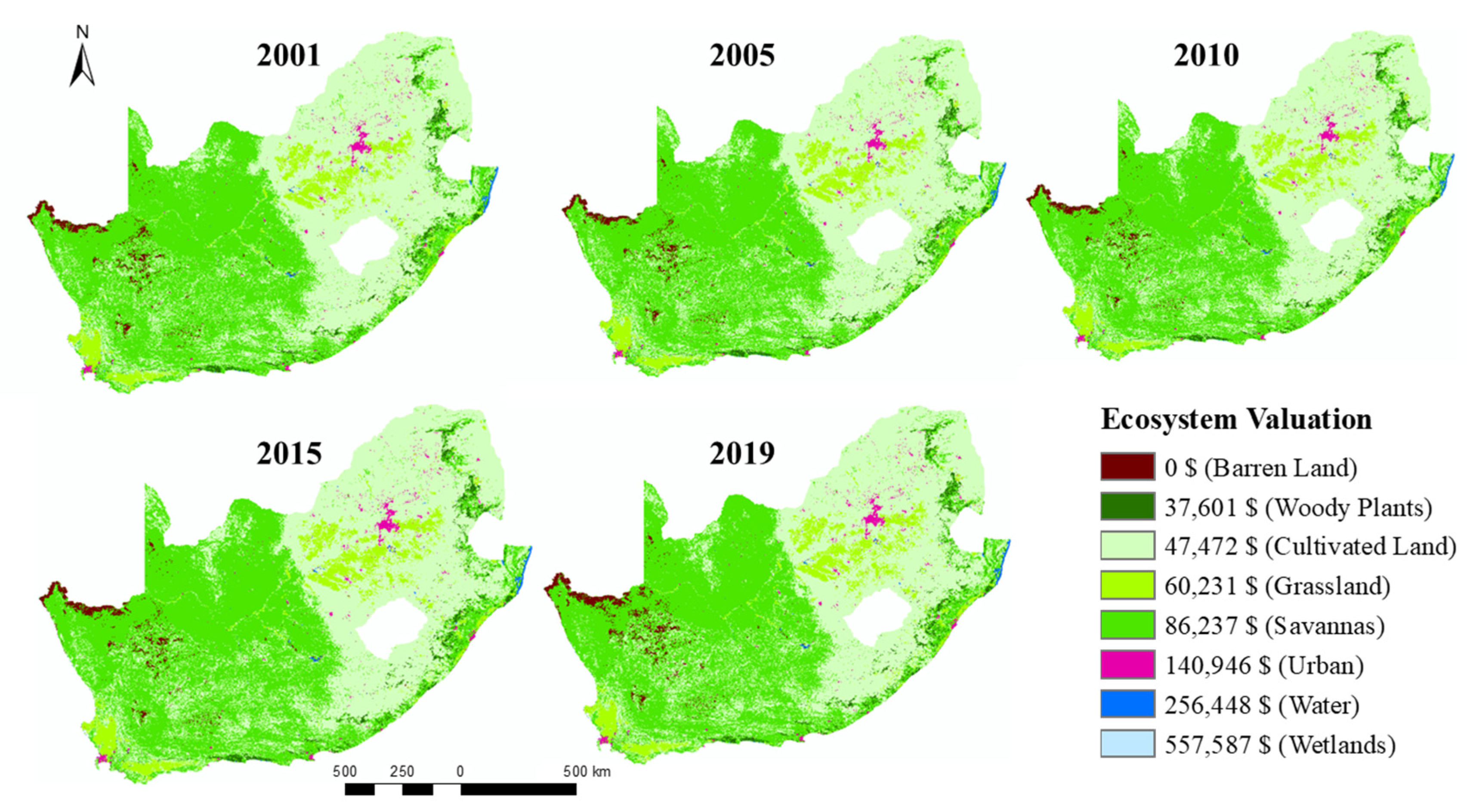
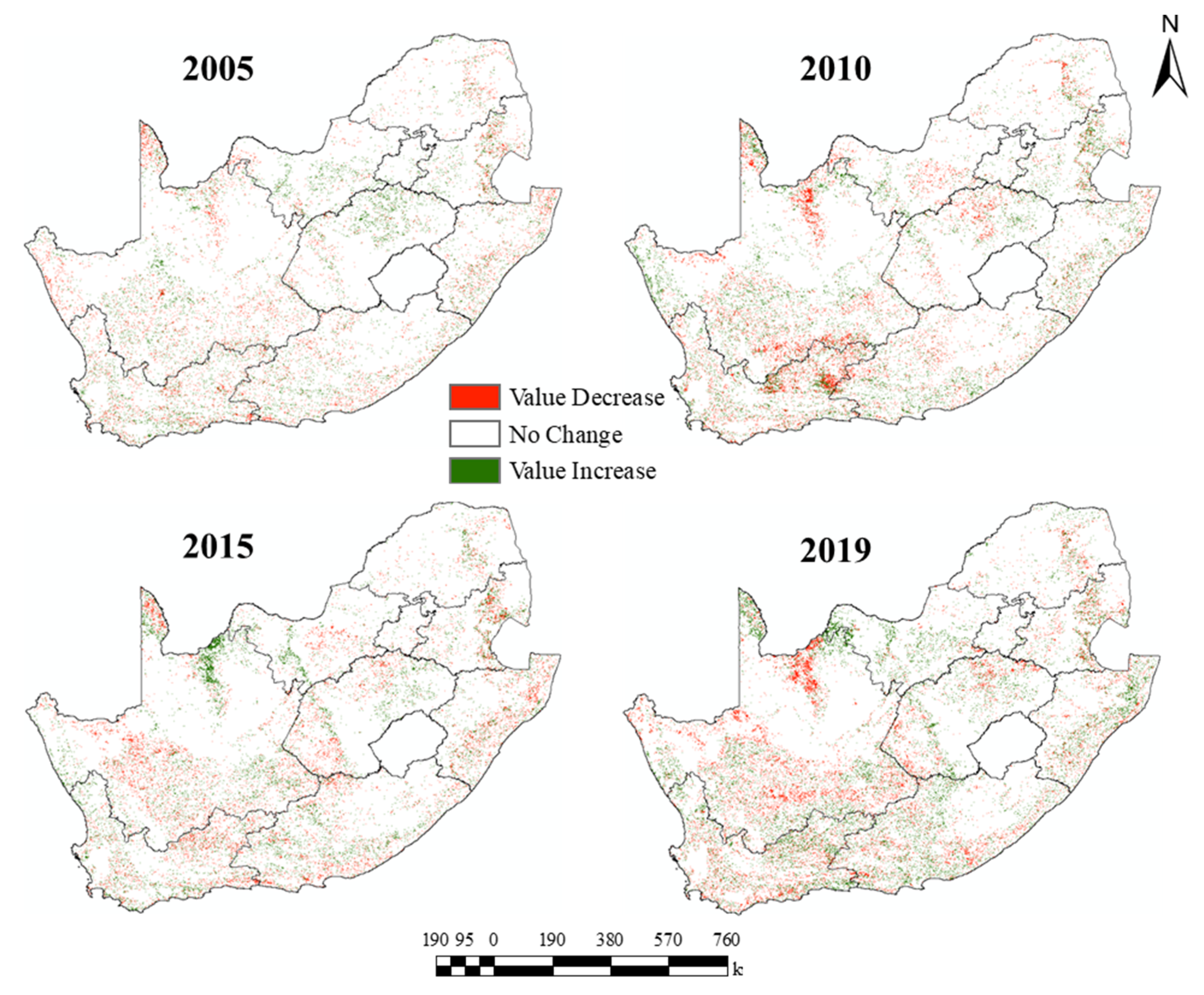
| # | Land-Cover Type | Value (USD ha−1 yr−1) |
|---|---|---|
| 0 | Water Bodies | 12,119.5 |
| 1 | Evergreen Needleleaf Forests | 1777.0 |
| 2 | Evergreen Broadleaf Forests | 1777.0 |
| 4 | Deciduous Broadleaf Forests | 1777.0 |
| 5 | Mixed Forests | 1777.0 |
| 6 | Closed Shrublands | 4075.5 |
| 7 | Open Shrublands | 4075.5 |
| 8 | Woody Savannas | 4075.5 |
| 9 | Savannas | 4075.5 |
| 10 | Grasslands | 4075.5 |
| 11 | Permanent Wetlands | 2243.5 |
| 12 | Croplands | 26,351.0 |
| 13 | Urban and Built-up Lands | 2846.5 |
| 14 | Cropland/Natural Vegetation Mosaics | 6661.0 |
| 15 | Non-Vegetated Lands | 2846.5 |
| % | |||||||
|---|---|---|---|---|---|---|---|
| # | Land-Cover Type | 2001 | 2005 | 2010 | 2015 | 2019 | Trajectory of Change |
| 0 | Water Bodies | 0.2224 | 0.2044 | 0.2177 | 0.2089 | 0.2073 | NC |
| 1 | Evergreen Needleleaf Forests | 0.0333 | 0.0382 | 0.0367 | 0.0617 | 0.0641 | ↑ |
| 2 | Evergreen Broadleaf Forests | 1.2002 | 1.1754 | 1.1129 | 1.1770 | 1.0676 | ↓ |
| 4 | Deciduous Broadleaf Forests | 0.2871 | 0.3523 | 0.4568 | 0.3599 | 0.4761 | ↑ |
| 5 | Mixed Forests | 0.0279 | 0.0469 | 0.0531 | 0.0631 | 0.0583 | ↑ |
| 6 | Closed Shrublands | 1.1898 | 1.3250 | 1.4388 | 1.4946 | 1.4685 | ↑ |
| 7 | Open Shrublands | 39.0436 | 38.7892 | 38.1479 | 38.2790 | 38.3849 | |
| 8 | Woody Savannas | 1.1491 | 1.0272 | 1.0424 | 1.0178 | 1.3505 | |
| 9 | Savannas | 3.9829 | 3.9289 | 4.4159 | 4.2918 | 3.9730 | NC |
| 10 | Grasslands | 45.7172 | 45.4929 | 45.5164 | 45.3610 | 44.5743 | ↓ |
| 11 | Permanent Wetlands | 0.0639 | 0.0599 | 0.0697 | 0.0688 | 0.0660 | |
| 12 | Croplands | 5.0030 | 5.4828 | 5.3914 | 5.3918 | 5.6418 | ↑ |
| 13 | Urban and Built-up Lands | 0.7516 | 0.7600 | 0.7749 | 0.7894 | 0.8079 | ↑ |
| 14 | Cropland/Natural Vegetation Mosaics | 0.1042 | 0.1074 | 0.1433 | 0.1399 | 0.1714 | ↑ |
| 15 | Non-Vegetated Lands | 1.2231 | 1.2087 | 1.1811 | 1.2946 | 1.6875 |
| Province (West To East) | Nationally | ||||||||||
|---|---|---|---|---|---|---|---|---|---|---|---|
| # | Land-Cover Type | NC | WC | NW | FS | EC | KZN | GT | MP | LIM | |
| 0 | Water Bodies | ↓ | ↓? | ↓ | ↓ | ↓? | NC | ||||
| 1 | Evergreen Needleleaf Forests | NP | ↑? | NP | ↑ | NP | ↑ | ↑? | ↑ | ||
| 2 | Evergreen Broadleaf Forests | NP | NP | NP | ↑? | NP | ↓? | ↓ | ↓ | ||
| 4 | Deciduous Broadleaf Forests | NP | ↑? | NP | ↑? | ↑ | ↑? | ↑? | ↑ | ||
| 5 | Mixed Forests | NP | NP | NP | ↑? | ↑ | NP | ↑ | ↑ | ↑ | |
| 6 | Closed Shrublands | ↑ | ↑ | NP | ↓? | ↑ | |||||
| 7 | Open Shrublands | ↓ | ↑ | ↓ | ↓? | ↓ | ↓ | ||||
| 8 | Woody Savannas | NP | ↑ | NP | ↓? | ↑ | |||||
| 9 | Savannas | ↑ | ↓ | ↑? | NC | ||||||
| 10 | Grasslands | ↑? | ↓ | ↓ | ↓ | ↓ | NC | ↓ | |||
| 11 | Permanent Wetlands | ↑ | ↑ | ||||||||
| 12 | Croplands | ↑? | ↓ | ↑ | ↑ | ↑ | ↑ | ||||
| 13 | Urban and Built-up Lands | ↑ | ↑ | ↑ | ↑ | ↑ | ↑ | ↑ | ↑ | ↑ | ↑ |
| 14 | Cropland/Natural Vegetation Mosaics | NP | ↑? | NP | ↑? | ↑ | ↑ | ||||
| 15 | Non-Vegetated Lands | ↑? | ↓? | NC | ↓ | ↑ | |||||
| Date | NC | WC | EC | FS | NW | KZN | GT | LIM | MP | TOTAL |
|---|---|---|---|---|---|---|---|---|---|---|
| 2001 | 157.851 | 53.625 | 59.959 | 41.157 | 33.283 | 32.020 | 63.099 | 32.822 | 21.116 | 438.146 |
| 2005 | 157.613 | 53.582 | 59.953 | 41.171 | 33.354 | 31.799 | 63.273 | 32.696 | 21.035 | 437.535 |
| 2010 | 157.350 | 53.361 | 60.157 | 41.309 | 33.464 | 32.052 | 63.663 | 32.682 | 21.360 | 438.105 |
| 2015 | 157.363 | 53.297 | 60.115 | 41.159 | 33.690 | 31.739 | 63.922 | 32.761 | 21.291 | 437.811 |
| 2019 | 154.887 | 53.509 | 60.620 | 41.207 | 34.383 | 32.059 | 64.428 | 32.698 | 21.230 | 437.038 |
| AVERAGE | 157.013 | 53.475 | 60.161 | 41.201 | 33.635 | 31.934 | 63.677 | 32.732 | 21.206 | 437.727 |
| 2019% of total national value | 35.86 | 12.21 | 13.74 | 9.41 | 7.68 | 7.29 | 1.45 | 7.47 | 4.84 | (100%) |
| 2019% national population | 2.15 | 11.64 | 11.42 | 4.91 | 6.85 | 19.20 | 25.82 | 7.47 | 7.81 | (100%) |
| 2018% contribution to GDP | 2.19 | 13.86 | 7.51 | 5.41 | 5.89 | 16.04 | 34.94 | 7.18 | 7.24 | (100%) |
Publisher’s Note: MDPI stays neutral with regard to jurisdictional claims in published maps and institutional affiliations. |
© 2021 by the authors. Licensee MDPI, Basel, Switzerland. This article is an open access article distributed under the terms and conditions of the Creative Commons Attribution (CC BY) license (https://creativecommons.org/licenses/by/4.0/).
Share and Cite
Abd Elbasit, M.A.M.; Knight, J.; Liu, G.; Abu-Zreig, M.M.; Hasaan, R. Valuation of Ecosystem Services in South Africa, 2001–2019. Sustainability 2021, 13, 11262. https://doi.org/10.3390/su132011262
Abd Elbasit MAM, Knight J, Liu G, Abu-Zreig MM, Hasaan R. Valuation of Ecosystem Services in South Africa, 2001–2019. Sustainability. 2021; 13(20):11262. https://doi.org/10.3390/su132011262
Chicago/Turabian StyleAbd Elbasit, Mohamed A. M., Jasper Knight, Gang Liu, Majed M. Abu-Zreig, and Rashid Hasaan. 2021. "Valuation of Ecosystem Services in South Africa, 2001–2019" Sustainability 13, no. 20: 11262. https://doi.org/10.3390/su132011262
APA StyleAbd Elbasit, M. A. M., Knight, J., Liu, G., Abu-Zreig, M. M., & Hasaan, R. (2021). Valuation of Ecosystem Services in South Africa, 2001–2019. Sustainability, 13(20), 11262. https://doi.org/10.3390/su132011262








